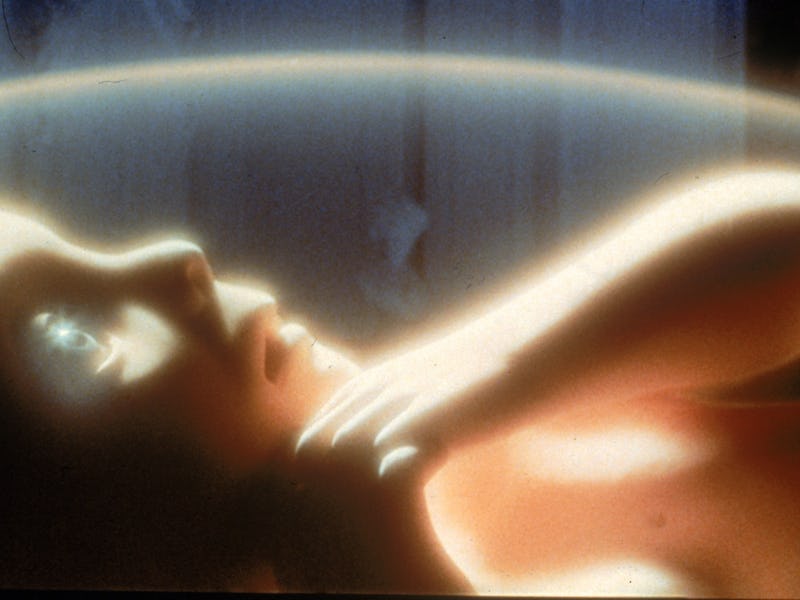It Turns Out Fetuses Can Recognize Faces
Scientists show that this ability arises before birth.

Scientists have long known that babies tend to turn their attention toward faces (or objects shaped like faces), but research suggests that fetuses in the third trimester of development could be able to recognize faces from inside the uterus.
In a study published Thursday in the journal Current Biology, researchers in the United Kingdom explain that fetuses prefer looking at face-like shapes, even through the uterus. Vincent Reid, a psychology researcher at Lancaster University and lead author of the study, says this research supports the idea that babies develop a preference for faces before they ever have any direct experience with them. This may sound strange, but it’s not far-fetched. After all, humans develop the skills to do many things long before we actually need to use those skills.
Reid likens this developmental pattern to the period when babies learn to crawl. Balance is required for crawling, but we learn how to balance before we learn how to crawl. The same, it seems, is true for recognizing people’s faces.
Research on infant facial recognition preferences suggests that babies respond to the general shape of the face, which is top-heavy, Reid tells Inverse.
Reid and his colleagues used techniques similar to those that would be used for tracking vision in infants but adapted them to the special conditions of the uterus.
“I’m actually not a fetus person,” says Reid, explaining that he usually works with infants.
To track fetal vision, the researchers shined a fairly dim light on the abdomens of 39 pregnant women in their third trimesters. They used 2D ultrasounds to identify where the fetuses’ faces were to ensure that the light was being placed within their visual fields. Researchers presented the light stimulus as a triangle of dots, either pointing up or down, and each subject received both orientations of light. The researchers moved the trio of lights across each mother’s abdomen at the same speed that infants have been shown to track movement.
Researchers shined small triangles of light (A and C) on the abdomens of pregnant women. Once the light filtered through the mother's tissues and into the uterus, it looked more like B and D.
Using 4D ultrasound, the researchers found that fetuses turned their heads toward the top-heavy, face-like light stimulus much more often than the inverted one. This suggests that infants and late-term fetuses share a preference for top-heavy shapes over the same shapes when they’re inverted. Not only that, but it also shows that the uterus lets in much more light than previously suspected.
Researchers used 4D ultrasound technology to track fetuses' head motions as they shined lights through the uterus.
Reid suspects that the facial shape preference has to do with the uterine environment. In a 2013 study of fetal mice, researchers found that pregnant female mice who lived in the dark gave birth to offspring with malformed eyes. This showed that light is required for the eye to fully develop, and he suspects that something similar could be happening with humans.
His second hypothesis is that the facial shape preference comes from the broken light pattern shining through the mother’s ribcage and the unbroken pattern shining through the uterus, a non-uniform pattern that is top-heavy.
“This is conjecture here,” Reid warns. And of course, both of these suspicions require further research to confirm. But with this research, scientists now know that fetuses toward the end of gestation already exhibit facial recognition habits similar to newborns. And it may go without saying, but Reid asks that you please don’t try using a flashlight to perform this experiment at home.
Abstract: In the third trimester of pregnancy, the human fetus has the capacity to process perceptual information. With advances in 4D ultrasound technology, detailed assessment of fetal behavior is now possible. Furthermore, modeling of intrauterine conditions has indicated a substantially greater luminance within the uterus than previously thought. Consequently, light conveying perceptual content could be projected through the uterine wall and perceived by the fetus, dependent on how light inter- faces with maternal tissue. We do know that human infants at birth show a preference to engage with a top-heavy, face-like stimulus when contrasted with all other forms of stimuli. However, the viability of performing such an experiment based on visual stimuli projected through the uterine wall with fetal participants is not currently known. We examined fetal head turns to visually presented upright and inverted face-like stimuli. Here we show that the fetus in the third trimester of pregnancy is more likely to engage with upright configural stimuli when contrasted to inverted visual stimuli, in a manner similar to results with newborn participants. The current study suggests that postnatal experience is not required for this preference. In addition, we describe a new method whereby it is possible to deliver specific visual stimuli to the fetus. This new technique provides an important new pathway for the assessment of prenatal visual perceptual capacities.